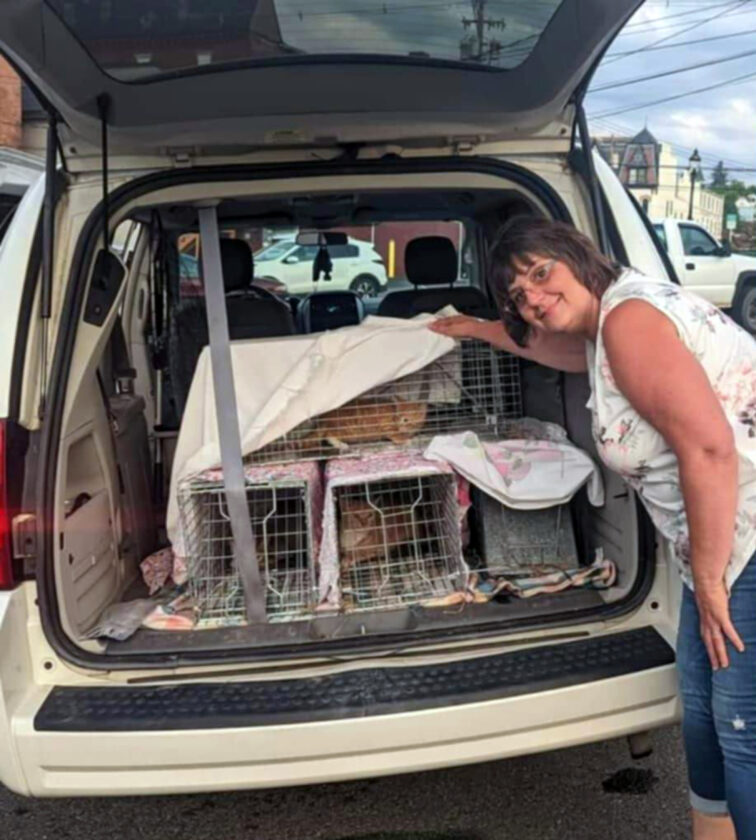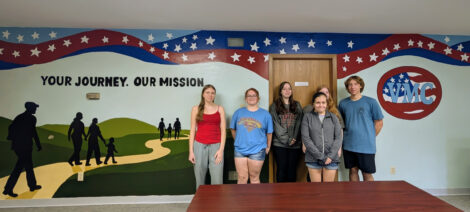‘An unfortunate reality’: Hope’s Dream Rescue & Sanctuary looks to help cats in Centre, Clinton areas

PHOTO PROVIDED Lesa King, Hope’s Dream’s founder and board president, is seen with a trunk full of stray cats that were being put through its Trap-Neuter-Release program.
HOWARD — Stray cats and colonies of felines are extremely common within Clinton and Centre counties alike.
Many who drive down a backroad, or even in the City of Lock Haven, may have experienced seeing these small, fluffy critters darting under porches, across streets or peeking from behind a tree or shrub.
Many organizations — including the ASPCA both in Clinton County and other regions — work tirelessly to try and lessen the number of outdoor cats and their colonies through its Trap-Neuter-Release (TNR) programs and other means.
Outside of a national organization, there are many rescues that work to do the same, including Hope’s Dream Rescue & Sanctuary.
Hope’s was started in 2016 by its founder and board president, Lesa King, and was originally based in the Howard and Centre County area.
Since the start, King has been able to grow the non-profit organization and expand its reach into Clinton County and Lock Haven.
King said the reason she started Hope’s was to assist individuals with the care of their pets and to try and decrease the feral and stray cat population.
The focus on cats, she told The Express, is because she feels they’re often overlooked.
“I feel that cats are a more discarded animal. You look at dogs, a lot of the time they’re usually pretty unique,” King said. “I just feel they’re more easily discarded.”
King emphasized she knows there are many cat owners that would never dream of releasing their own feline companions into the outdoors, but it’s an unfortunate reality for some cats.
Catrina Armstrong, events and public relations expert for Hope’s, agreed with King.
“There are a lot more (cats) discarded than dogs. When there is a dog discarded a community comes together. Meanwhile, no one really bats an eye when a cat is abandoned,” Armstrong said.
King and Armstrong noted Hope’s doesn’t turn away assisting a dog that’s in need.
“We do try to take in dogs when we’re able. It’s just harder to take in a dog without knowing its history,” King said. “Some of (our volunteers) have kids and other animals.”
Hope’s Dream Rescue is all volunteer based, with King sheltering a number of the strays that are brought in and other volunteers providing foster homes, participating in live trapping colonies or taking part in the TNR program.
“We mainly bring animals in, rehabilitate them, vet them and rehome them,” King explained. “But sometimes it seems like TNR is right up there, ranking pretty even with it.”
“The numbers with TNR are astonishing — in the past few years we’re at about 1,000 TNRs in different areas in Centre and Clinton,” she continued. “There’s just such a need for it.”
Since Hope’s first began nearly 10 years ago, King said the non-profit has been able to help about 880 cats.
Armstrong noted the increase in TNR participation is crucial.
“We often say we’re draining the ocean with a teaspoon. The only way for there to be less animals that need us is for there to be less animals born in the first place,” she said. “We really push the TNR education programs. If we spay and neuter to begin with then we don’t need to find emergency placement for as many.”
Both noted there are a variety of resources outside of the non-profit for the TNR program.
“Both Clinton and Centre counties have amazing resources for TNR. Something that we do struggle with is people not wanting to do anything because they’re not their cats,” Armstrong said. “They’re not ours either, but we’re out there doing it every week.”
When it comes to fostering, King said Hope’s Dream Rescue is completely foster based.
“The only physical aspect of the rescue is my end, which is a sanctuary. I have all the hospice, special needs animals — the ones that people consider ‘non-adoptable,'” she explained. “We honestly feel there aren’t any non-adoptable animals. There just needs to be that special home for them.”
When it comes to the foster home volunteers, King said Hope’s Dream Rescue will provide supplies and other items they’d need to properly foster.
“We provide everything for them — food, litter and all the vet visits. If they need help transporting to the vet appointments, we do that as well,” she said. “We provide emotional support too — we have a big foster chat where some more experienced fosters are there to help our newbies.”
The majority of Hope’s Dream Rescue’s work is done in Centre County, though it does trap occasionally in Clearfield and has seen a large growth in Clinton County.
Armstrong noted a board member has typically lived in Clinton County since she started working with the non-profit in 2018. Currently there are two board members that reside in the county.
“We’ve always kind of had a toe over the border of the county,” she said. “We’ve seen where we have as many fosters in Clinton County as in Centre.”
In total, there are 12 foster volunteers along with many who assist with the TNR program and transporting animals.
And the non-profit receives funding mostly through donations, with a couple of grants and municipality based funds coming in.
“We have definitely received some grants, including the Lock Haven City donation. We’ve also received a couple of grants specifically for TNR from the Centre Foundation — used for specific items — and the 3DOT,” Armstrong said.
Outside of these sources, Hope’s Dream Rescue holds fundraisers and accepts donations through Paypal, Venmo and through its Facebook page.
Those who may be interested in volunteering can consider fostering animals or learning more about the TNR program.
“There’s an application to fill out. Their animals have to be up-to-date and altered. We check with landlords to make sure they are allowed to have additional animals, too,” King said. “We kind of do things to a ‘T’ to make sure that we’re not violating landlords’ policies and if there’s a pet policy we make sure that’s covered.”
For TNR, volunteers are asked to fill out liability waivers.
“There’s always paperwork with stuff no matter which aspect,” King said.
Armstrong noted that, because the non-profit doesn’t have a physical location, the TNR program and volunteering at local events would be another good way for interested individuals to help Hope’s Dream Rescue’s mission.
Reflecting on the work she’s done in the past 10 years, King said she’s happy with the way Hope’s Dream Rescue operates.
She explained that shelters offer a very important service, but feels Hope’s offers a “homey” feel.
Armstrong agreed, noting this can help assess a cat to better find their perfect home.
“We’re better able to get a sense of their likes and dislikes. Home based foster better gives us an idea on those things,” she said.
For those interested in learning more about Hope’s, you can visit “Hope’s Dream Rescue & Sanctuary” on Facebook.


